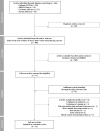The effects of shoe type on lower limb venous status during gait or exercise: A systematic review
- PMID: 33237916
- PMCID: PMC7688113
- DOI: 10.1371/journal.pone.0239787
The effects of shoe type on lower limb venous status during gait or exercise: A systematic review
Abstract
This systematic review evaluated the literature pertaining to the effect of shoes on lower limb venous status in asymptomatic populations during gait or exercise. The review was conducted in accordance with PRISMA (Preferred Reporting Items for Systematic Reviews and Meta-Analyses) guidelines. The PubMed-NCBI, EBSCO Host, Cochrane Library and Science Direct databases were searched (March 2019) for words around two concepts: shoes and venous parameters. The inclusion criteria were as follows: (1) the manuscript had to be published in an English-language peer-reviewed journal and the study had to be observational or experimental and (2) the study had to suggest the analysis of many types of shoes or orthotics on venous parameters before, during and/or after exercise. Out of 366 articles, 60 duplications were identified, 306 articles were analyzed, and 13 articles met the eligibility criteria after screening and were included. This review including approximately 211 participants. The methodological rigor of these studies was evaluated with the modified Downs and Black quality index. Nine studies investigated the effect of shoes on blood flow parameters, two on venous pressure and two on lower limb circumferences with exercise. Evidence was found that unstable shoes or shoes with similar technology, sandals, athletic or soft shoes, and customized foot orthotics elicited more improvement in venous variables than high-heeled shoes, firm shoes, ankle joint immobilization and barefoot condition. These venous changes are probably related to the efficiency of muscle pumps in the lower limbs, which in turn seem to be dependent on shoe features associated with changes in the kinetics, kinematics and muscle activity variables in lower limbs during gait and exercise.
Conflict of interest statement
The authors have declared that no competing interests exist.
Figures
References
Publication types
MeSH terms
LinkOut - more resources
Full Text Sources
Miscellaneous


